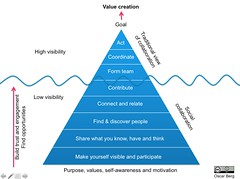By Guest Writer +Aaron Seigo
| The Collaboration Pyramid (Photo credit: oscarberg) |
Collaboration Between Free Software Communities Free software development derives momentum from a set of competing principles: competition and cooperation. The ability for anyone to choose to work with the technology on their terms, including forking it, creates an environment of healthy competition that prods individuals, companies and communities forward. Free software projects are also able to collaborate openly with each other to share development costs and sharpen ideas. Recently we've seen rather more of the competition side of this dynamic in the form of forking, projects diverging on bad terms and walled-garden development. Collaboration seems to have taken a back seat in all this and Free software communities are in need of support in this area.
| This is the official logo of the freedesktop.org project. (Photo credit: Wikipedia) |
Collaboration Spaces In 2000, a collaboration project, was founded to build a base platform for Free desktop software. Called freedesktop.org, it focused on infrastructure technology and its early successes were numerous leading to a new level of continuity for Free software desktop users. Basic things like drag and drop and application menus were finally standardized and collaboration between the two dominant projects of the day were brought to new heights.
Unfortunately, no process or governance guidelines were laid down when freedesktop.org was founded. The participants opted instead for a more fluid approach, reflecting how many Free software projects were typically run at the time. This lack of structure led to the slow decline of freedesktop.org as a collaboration zone. Fewer specifications were created, fewer were broadly adopted and discussion dwindled, today dominated by off-topic inquiries on a quiet mailing list. Collaboration became so difficult that many developers grew disillusioned and simply walked away.
Attempts to to improve freedesktop.org from within met with stop energy. Today, freedesktop.org is primarily a source code hosting service.
Changing Landscapes
While freedesktop.org was faltering, the Free software landscape was evolving. Today the desktop is only one form factor in a continuum including handsets, tablets, media centers and in-vehicle displays. Online services, mobile applications and web frameworks have extended and blurred the lines that once sharply defined the “the desktop”.
The number of Free software desktop communities has also bloomed. In 2000, there were essentially two that were active, dynamic and had large user bases. Now, there are dozens of them. The number and variety of desktop environments bloomed in recent years, and significant communities have blossomed around individual application suites. More companies have become deeply involved and the
Free software projects themselves have become more sophisticated in their organization: non-profit foundations are now the norm rather than the exception. It's an embarrassment of riches on the one hand, but collaboration in general has not kept pace with this changing landscape resulting in a disjointed and inefficient landscape with much unrealized potential ... and therein lies the opportunity.
Co-creating the Next Collaboration Zone
Creating and maintaining the structure of a collaboration zone is probably a task better suited to people who aren't software developers. Not only are they often overly busy with their development tasks, managing a collaboration space takes a set of skills rarely found in engineers. Those skills can, however, be found amongst the community of Free software users.
A platform for collaboration built and managed by dedicated users would not only provide a new way to become constructively involved with Free software, it could also remove an inherent conflict of interest that arises when people re tending the space in which technologies from their own projects are being offered for standardization.
| Collaboration logo. (Photo credit: Wikipedia) |
The opportunity to simultaneously address two important, seemingly disparate challenges is a rare one. All that is needed now is for a few intrepid souls to take on the challenge.
-- Aaron Seigo
















0 comments:
Post a Comment